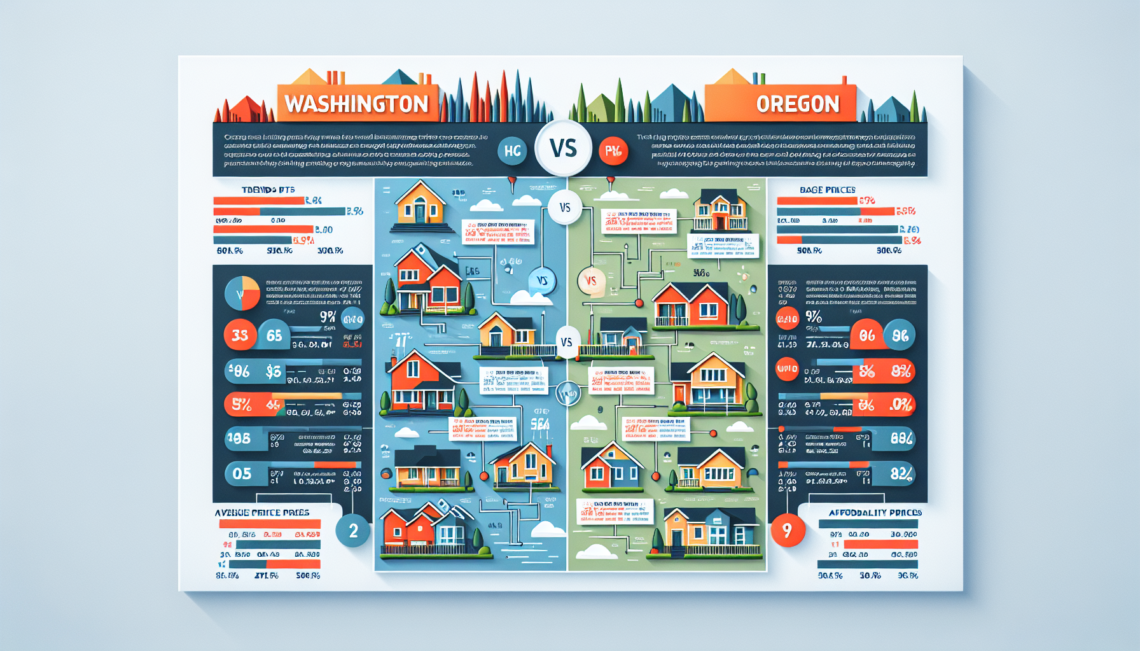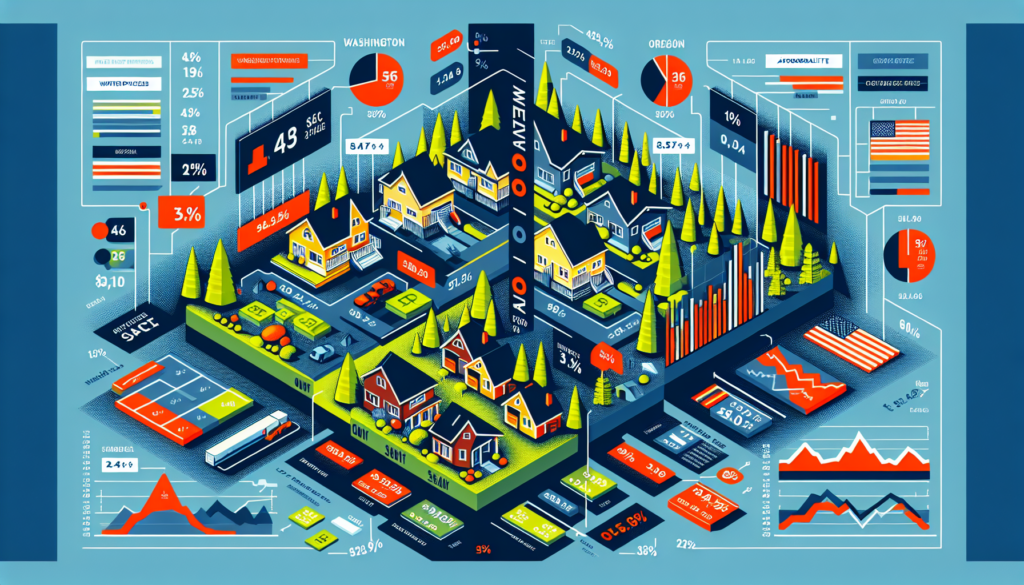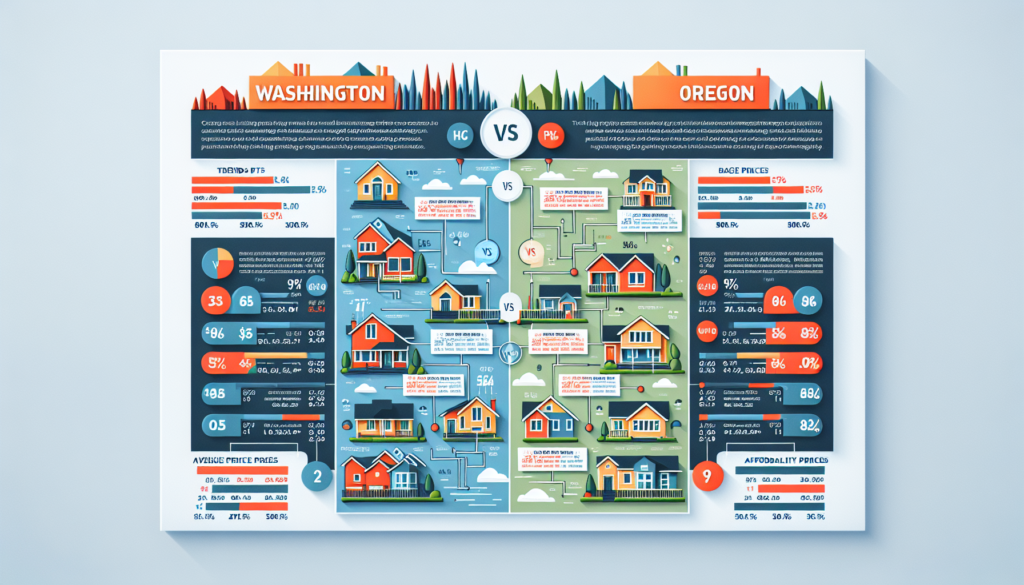
Housing Price Comparison: Washington vs. Oregon
If you’ve ever wondered whether houses in Washington or Oregon come with a higher price tag, this article has got you covered. We’ll be diving into a detailed housing price comparison between these two stunning states, allowing you to gain a clearer understanding of where your hard-earned money might stretch a little further. So, whether you’re planning a move, investing in real estate, or simply curious about the market, get ready to explore the captivating world of housing prices in Washington and Oregon. It’s time to find out which state takes the crown in this friendly competition!

Table of Contents
ToggleFactors Affecting Housing Prices
When it comes to housing prices, several factors come into play. Understanding these factors can help you make informed decisions about buying or renting a home. Some of the key factors that affect housing prices include location, economy, population growth, education and employment opportunities, supply and demand, and government policies.
Location
One of the primary factors influencing housing prices is the location of the property. In general, houses located in desirable areas with good amenities, such as schools, parks, and shopping centers, tend to have higher prices. Additionally, proximity to job opportunities and transportation hubs like highways or public transportation can impact housing prices.
Economy
The state of the economy plays a significant role in determining housing prices. When the economy is thriving, with steady job growth and high wages, housing prices tend to rise. Conversely, during economic downturns or recessionary periods, housing prices may decrease due to reduced demand and financial instability.
Population Growth
Population growth can also have a significant impact on housing prices. As the population increases, the demand for housing rises, leading to higher prices. This is especially true in areas with limited available land for development. Conversely, in areas where population growth is stagnant or declining, housing prices may stand stagnant or even decrease.
Education and Employment Opportunities
The availability of quality education and employment opportunities can greatly influence housing prices. Areas with renowned schools and prestigious universities often attract families and individuals willing to pay a premium for housing in those locations. Additionally, regions with thriving job markets and diverse industries tend to have higher housing prices due to increased demand.
Supply and Demand
The basic principle of supply and demand affects housing prices significantly. When the demand for housing is greater than the available supply, prices tend to rise. Conversely, when the supply of housing outstrips the demand, prices may decrease. Factors such as construction rates, land availability, and zoning regulations impact the supply of housing in a given area.
Government Policies
Government policies also play a role in shaping housing prices. Regulations and zoning laws can restrict the supply of housing or increase the cost of construction, leading to higher prices. Additionally, policies aimed at incentivizing homeownership or supporting affordable housing programs can have an impact on housing prices in a given region.
Housing Price Trends
Understanding housing price trends is essential for making informed decisions regarding buying or renting a property. Analyzing overall comparisons, regional differences, and differences between urban and rural areas can provide valuable insights.
Overall Comparison
When comparing housing prices between different states or regions, it is crucial to consider various factors such as location, economic conditions, and population growth. In the case of Washington and Oregon, an overall comparison of housing prices indicates that homes in Washington tend to be more expensive than in Oregon.
Regional Differences
It is important to note that housing prices can vary significantly within a state or region. Within Washington and Oregon, different cities and areas may have distinct housing price trends. For example, urban areas like Seattle or Portland generally have higher housing prices compared to smaller towns or rural areas.
Urban vs. Rural Areas
Urban and rural areas within a state can have striking differences in housing prices. Urban areas, with their higher demand and proximity to amenities, often have higher housing prices. In contrast, rural areas may offer more affordable housing options due to lower demand and fewer amenities.
Cost of Living
When considering housing affordability, it is essential to take into account not only the housing prices but also the overall cost of living. This includes factors such as basic needs, transportation costs, taxes, and utility expenses.
Comparison of Basic Needs
The cost of basic needs, such as groceries, healthcare, and childcare, can vary between states and regions, influencing the overall cost of living. It is crucial to consider these factors alongside housing prices to get a clear picture of affordability.
Transportation Costs
Transportation costs, including gas prices and commuting expenses, can vary depending on the availability of public transportation and the proximity to job centers. Higher transportation costs can impact the overall cost of living and housing affordability.
Taxes
Taxes, including income tax, property tax, and sales tax, can vary between states and have an impact on the cost of living. It is important to consider the tax rates and any potential deductions or exemptions when evaluating housing affordability.
Utility Expenses
Utility expenses, such as electricity, water, and heating, can significantly impact the cost of living. Prices for utilities can vary depending on the region and climate, so it is crucial to consider these costs when assessing housing affordability.
Average Home Prices
Comparing average home prices can provide insight into the affordability of housing within a state or region. Analyzing statewide comparisons, city comparisons, and comparisons based on home types can help you understand the housing market better.
Statewide Comparison
When comparing average home prices statewide, it is important to consider various factors such as location, population, and economic conditions. In the case of Washington and Oregon, the average home prices in Washington are generally higher than in Oregon.
City Comparison
Different cities within a state can have significantly different average home prices. Factors such as demand, amenities, and job opportunities can influence housing prices within a particular city. Comparing average home prices between cities can help identify more affordable housing options.
Home Type Comparison
Comparing average home prices based on home types, such as single-family homes, townhouses, or condominiums, can provide valuable insights. Different home types may have distinct price trends within a state or region, allowing potential homebuyers to explore various options.

Real Estate Market
Analyzing various aspects of the real estate market, such as sales volume, days on market, housing inventory, and market forecasts, can help gauge the current conditions and predict future trends.
Sales Volume
The volume of home sales in a specific area can indicate the level of market activity. Higher sales volumes may suggest a robust housing market and potentially higher prices, while lower volumes might indicate a slower market or lower demand.
Days on Market
The average number of days a property stays on the market before being sold can provide insights into market competitiveness and demand. Shorter days on market may indicate high demand and competitive pricing, while longer days on market may suggest a slower market or overpricing.
Housing Inventory
The number of available homes for sale, also known as housing inventory, can impact housing prices. When the inventory is low, demand may outweigh supply, causing prices to rise. Conversely, a high inventory may result in lower prices due to increased competition among sellers.
Market Forecast
Examining market forecasts and expert opinions can provide insights into future trends. Economic projections, population growth, and infrastructure development plans can all impact the real estate market, potentially affecting housing prices.
Affordability Index
The affordability index compares the median income to the median home price, providing an indication of the affordability of housing in a given area. Additionally, affordable housing programs and initiatives targeted towards first-time homebuyers can play a crucial role in improving affordability.
Median Income vs. Median Home Price
Comparing the median income of residents to the median home price can highlight the affordability challenges in a particular area. When the price-to-income ratio is high, it may indicate a less affordable housing market.
Affordable Housing Programs
Affordable housing programs, such as subsidized housing or down payment assistance programs, aim to improve housing affordability for lower-income individuals and families. These programs can make homeownership more attainable for those who qualify.
First-Time Homebuyers
First-time homebuyers often face unique challenges when entering the housing market. Programs specifically designed for first-time buyers, such as tax incentives or loan programs, can help overcome these challenges and make homeownership more affordable.
Renting vs. Buying
Deciding between renting and buying a home depends on various factors, including comparative rental prices, the pros and cons of renting, and the pros and cons of buying.
Comparative Rental Prices
Comparing rental prices to the cost of homeownership is crucial in determining affordability. In some cases, renting may be more cost-effective than buying, particularly if housing prices are high or if you have short-term housing needs.
Pros and Cons of Renting
Renting offers flexibility and fewer responsibilities compared to homeownership. It allows you to avoid long-term commitments and provides more mobility. However, renting means you don’t build equity, and you may face rent increases and limited control over the property.
Pros and Cons of Buying
Buying a home offers the potential for long-term equity building and stability. It provides you with the freedom to make changes to your property and the potential for financial benefits in the future. However, homeownership requires a long-term commitment, financial responsibility, and ongoing maintenance costs.
Factors Impacting Future Prices
Several factors can impact future housing prices. Considering population projections, economic outlooks, infrastructure development, and real estate market predictions can help anticipate potential price changes.
Population Projection
Analyzing population projections can provide insight into future housing demand. Population growth, migration patterns, and demographic changes can all impact housing prices.
Economic Outlook
Understanding the economic outlook, including job growth, wage trends, and industry shifts, can help predict housing market conditions. A strong economy with stable job markets often correlates with rising housing prices.
Infrastructure Development
Investment in infrastructure, such as transportation systems, schools, and public amenities, can influence housing prices. Areas experiencing significant infrastructure development may see increased demand and higher housing prices.
Real Estate Market Predictions
Following real estate market predictions and expert opinions can help gain insights into potential future trends. Forecasts based on economic indicators, market data, and historical trends provide valuable information for buyers, sellers, and investors.
Homeownership Rates
Examining homeownership rates can provide an overview of homeownership trends within a state or region. Comparing overall rates and analyzing variation by demographics, such as age group, income level, or ethnicity, can offer insights into the factors influencing homeownership.
Comparison of Overall Rates
Comparing overall homeownership rates between states can highlight differing trends and reveal factors that contribute to higher or lower rates. This includes analyzing factors such as housing affordability, employment opportunities, and cultural norms.
Variation by Demographics
Ownership rates can vary significantly based on demographics. Factors such as age, income level, and education level can influence homeownership rates. Analyzing variation by demographics can help identify disparities and potential barriers to homeownership.
Renters vs. Owners
Understanding the ratio of renters to owners in a particular area can indicate the prevailing housing market conditions. A higher proportion of renters may suggest a higher demand for rental properties or barriers to homeownership.
Conclusion
When it comes to housing prices, various factors come into play. Location, economy, population growth, education and employment opportunities, supply and demand, and government policies all impact the cost of housing. By understanding these factors and analyzing housing price trends, cost of living, average home prices, real estate market conditions, affordability index, renting vs. buying considerations, future price impacts, and homeownership rates, you can make informed decisions related to housing. Whether you are looking to buy or rent, considering these factors will help you navigate the complex world of housing prices and find the best option for your needs and budget.
You May Also Like

Rentals at Providence Academy and Officers Row
2 September 2023
Best Jobs in Clark County, Washington
29 August 2023





